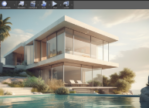Bring Your Dream Home to Life with Visual Rendering

As the saying goes, a picture is worth a thousand words. When it comes to bringing your dream home to life, visual rendering can be an incredibly powerful tool. Not only does it allow you to see what your home will look like before it’s built, but it can also help you make important design decisions and communicate your vision to builders and contractors. In this blog post, we’ll explore the many benefits of visual rendering and why it’s a must-have tool for anyone who wants to build their dream home.
What is Visual Rendering?
Visual rendering, also known as 3D rendering or 3D visualization, is a process that uses computer software to create lifelike images of architectural designs. These images can be anything from a single room to an entire building, and they allow you to see what your project will look like from any angle.
The process of visual rendering involves creating a 3D model of your design, applying textures and materials, and then using lighting and other effects to create a realistic image. The result is a highly detailed image that accurately represents your design, allowing you to see exactly what your finished project will look like.
Benefits of Visual Rendering
There are many benefits to using visual rendering when designing your dream home. Here are just a few:
See your design before it's built
One of the most significant benefits of visual rendering is that it allows you to see what your home will look like before it’s built. This can be incredibly helpful when making design decisions, as it allows you to visualize different options and see which ones work best.
For example, you may be unsure whether to go for an open-plan layout or a more traditional design. By using visual rendering, you can see both options and make an informed decision based on what looks best.
Catch design flaws early
Another benefit of visual rendering is that it can help you catch design flaws early on. By seeing your design in 3D, you can identify potential issues that may not have been apparent from 2D drawings or blueprints
This can save you a lot of time and money in the long run, as it allows you to make changes before construction begins. It can also help you avoid costly mistakes that could have been easily avoided with the help of visual rendering.
Communicate your vision to builders and contractors
Visual rendering can also be incredibly helpful when communicating your vision to builders and contractors. By showing them a realistic 3D image of your design, you can help them better understand what you want and ensure that everyone is on the same page.
This can be particularly important when working with builders and contractors who may not have experience with the type of design you’re going for. By using visual rendering, you can ensure that they understand your vision and can work towards making it a reality.
Save time and money
Finally, visual rendering can save you both time and money in the long run. By catching design flaws early and communicating your vision clearly, you can avoid costly mistakes and ensure that your project is completed on time and within budget.
This can be particularly important if you’re working with a tight budget or on a timeline. By using visual rendering, you can ensure that you’re making the most of your resources and that your project is completed to the highest possible standard.
How to Get Started with Visual Rendering
If you’re interested in using visual rendering to bring your dream home to life, there are a few things you’ll need to do to get started.
Hire a visual rendering professional
The first step is to hire a visual rendering professional. This could be an architect, designer, or specialist 3D rendering company. They will be able to create a 3D model of your design and turn it into a realistic image that accurately represents your vision.
When choosing a visual rendering professional, it’s important to do your research and find someone who has experience in the type of design you’re going for. Look for someone who has a portfolio of similar projects and can provide references from previous clients.
Provide detailed information about your design
Once you’ve found a visual rendering professional, you’ll need to provide them with detailed information about your design. This should include everything from the layout and dimensions of the rooms to the materials and finishes you want to use.
The more information you can provide, the more accurate and realistic the final image will be. You may also want to provide examples of other designs or styles that you like, as this can help the visual rendering professional to better understand your vision.
Review and provide feedback on the initial design
After the visual rendering professional has created the initial design, you’ll need to review it and provide feedback. This is your opportunity to make changes and ensure that the final image accurately represents your vision.
Be sure to take your time and review the design from all angles. Look for potential design flaws or areas that could be improved. You may also want to get feedback from family members or friends to get a second opinion.
Finalize the design and use it to guide construction
Once you’re happy with the final design, you can use it to guide construction. The visual rendering will provide a highly detailed and accurate representation of your vision, allowing builders and contractors to create your dream home to your exact specifications.
How to Use 3D Rendering in Interior Design
Conclusion
Visual rendering is an incredibly powerful tool for anyone who wants to bring their dream home to life. By creating a highly detailed and realistic image of your design, you can see what your home will look like before it’s built, catch design flaws early, communicate your vision to builders and contractors, and save time and money in the long run.
If you’re planning to build your dream home, be sure to consider using visual rendering to help bring your vision to life. With the help of a professional visual rendering specialist, you can create a design that accurately represents your vision and guides construction to create the home you’ve always dreamed of.



